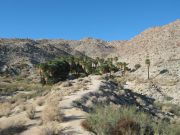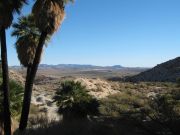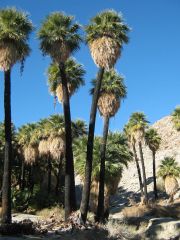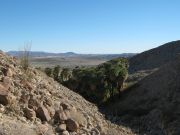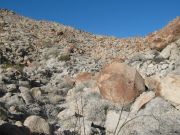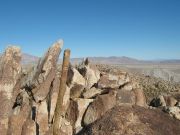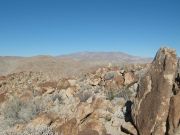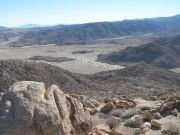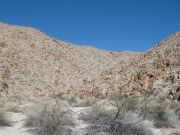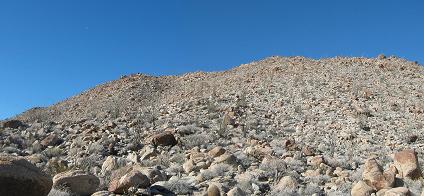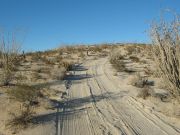
The Mountains of California
www.surgent.net |
| Palm Benchmark • South Peak |
• Anza-Borrego Desert State Park • Tierra Blanca Mountains • San Diego County |
Date: December 26, 2013
• Elevation: 1,940 feet
• Prominence: 250 feet
• Distance: 4 miles
• Time: 3 hours
• Gain: 1,100 feet
• Conditions: Sunny and nice
California
•
Main
•
PB
Palm Springs Mountain is a small rocky hill in the Anza-Borrego Desert State Park in San Diego County. We were here to celebrate Christmas by camping a few nights at the Bow Willow Campground. We left home on Christmas afternoon, arriving to Bow Willow nearing sunset. I had just enough daylight to erect our brand-new large-size tent, our Christmas gift to ourselves.
The night was cold, but we slept well. The campground was only about a third full. The next morning, the 26th, we awoke and milled around camp, enjoying the solitude and spectacular desert scenery. From our site, we could look east and see as far as the Chocolate Mountains, which lie on the opposite side of the Salton Sea, about 70 miles distant.
My objective for this morning was the summit of Palm Mountain, which rises north of the Bow Willow campground, hemming in the Bow Willow Canyon. The map does not cite this peak by name, just the benchmark "Palm", which is not at the true summit. Only a few signs along the trail give hint to this peak's name. From the campground, the peak is less than a mile away, about 900 feet higher. However, my plan included a hike from the northeast up a canyon and some groves of palm trees that grow in clumps deep within the canyons.
From Bow Willow, I walked past the day-use parking area and went right at a sign, following this branch of trail about a mile across the sandy desert. The trail is sometimes ill-defined, but tracks in the sand, or small wooden posts, mark the way. Soon, the trail was circumscribing the lowest of the slopes, then it dropped into a canyon, with a glade of palms up ahead.
The palm trees grow in tight clusters at points within the canyon, wherever there happens to be groundwater to water them. There are about four or five such groves in these hills. Their green fronds stand out against the tan-colored desert slopes. I walked into the grove ahead of me (called the Southwest Grove on the map) and took a short break to admire this little oasis
Past this grove, I continued up the canyon, the trail by now having disappeared into nothing. The canyon was well defined and the rocks easy to hop, with minimal brush, so that I made good time. The main canyon bends west and in about a quarter-mile, I had climbed about 400 feet to a saddle at elevation 1,380 feet. Looking down into the parallel canyon, I could see more groves. I took another break in the shade. Being the day after Christmas, it was surprisingly warm here.
By now, my objective was the peak, now about a half-mile to the southwest. I eyeballed the terrain and marveled at the abundance of rocks. It looked friendly, so I continued on my way, dropping about a hundred vertical feet to emerge into this second canyon. Here, the grade lessened and I walked south a little to a sloping rib of rocks, east of Palm Benchmark as shown on the map.
The map shows a larger 1,920-foot contour a little south of the Palm Benchmark (which is listed at 1,927 feet). The ridge between the two points form a rough crescent. My plan was to aim for the presumed summit toward the south, and visit the north peak (Palm Benchmark) only if I felt it necessary.
I walked up the slopes, which got a little steep in spots, but soon, I was approaching the ridgeline. The rocks here were much more dramatic, some forming tall spires, others leaning against one another to form odd shapes and voids. I had no direct view of the south summit until I was nearly upon it. I arrived here about 90 minutes after starting the hike, relieved to find that (a) was not some unclimbable spire and (b) that is was undoubtedly higher than Palm Benchmark.
I spent a few minutes here, in no hurry, admiring the views. East were the Fish Creek Mountains, lots of desert and badlands, and views of the Salton Sea, plus views of the Coyote Mountains and of Cerro Centinela in Mexico. West were the wall of peaks forming the coastal ranges toward San Diego, and north were more big peaks, including Whale Peak. I could see Bow Willow Canyon and the campground immediately south of my position. The day was stupendous, with bright blue skies and not a single cloud.
Looking north at the 1,927-foot Palm Benchmark summit, it was clearly lower by about 20 feet, there being no doubt in my mind. Thus, I had no desire to walk to those rocks. I looked for a summit log but found none. However, I did find a small baboon-face that someone had buried in some rocks. I was amused, then I covered it back up for the next visitor.
I debated my route: I could go back north and check out the other palm groves, or try my luck with the southern slopes and make a beeline back to camp. I decided to do the latter, since it looked like a fun challenge, and the slopes looked manageable.
I dropped off the summit and picked my way down the slopes, which were never too steep. Only in one or two spots did I need to butt-scoot down rock jumbles. I dropped elevation quickly and in minutes had descended onto an elevated bench of rocky desert, still a couple hundred feet above Bow Willow Canyon. I had a choice of canyons to descend, and chose one that worked well, and after about 30 minutes from the top, was now standing in the sandy floor of Bow Willow Canyon. From here it was about a half-mile trek back to camp, my total time gone slightly less than three hours. I roughly gauged my total distance to be about 4 miles, with about 1,100 vertical feet of gain when drops were taken into account.
She was enjoying herself at camp, which was nearly vacant by now. Later in the afternoon a few more people rolled in. My feet still itchy, I decided to hike to little Egg Mountain, elevation 902 feet, about a mile west. This little hump of sand lies beside the main highway and the road to camp, and a side road goes to its top. We drove this road to the top years ago. Anyway, I wanted a stroll, so I walked to the top. The top affords nice views of the surrounding valley and I snapped a few photographs. The round trip hike covered 2.5 miles and cost me an hour of my life.
I was back to camp as the sun was setting. As soon as the sun went behind the hills, the temperature dropped about 10 degrees. I built us a nice fire and we enjoyed another pleasant evening under the stars. The next day we soaked at the Agua Caliente Hot Springs up the road, then two days later, I hiked to the top of Mine Benchmark in the Coyote Mountains.
Hike to Egg Mountain. Egg Mountain is a small sandy hill sitting beside the Imperial Highway at the turn-off to the Bow Willow. The summit is just 902 feet high, with about 60 feet of prominence, and a road goes to the top. But it does allow for good vantage points for photos, and if one needs to check their cell-phones, reception is usually found here.
|
|

